Philippine Economic Debate: Demand Stimulus and Fiscal Policy
VerifiedAdded on 2023/05/30
|10
|2511
|60
Essay
AI Summary
This essay delves into the intricate relationship between fiscal and monetary policies in the Philippines and their impact on economic recovery. It begins by defining economic recovery and highlighting key indicators used in the Philippines, such as GDP, financial markets, inflation, and unemployment. The essay discusses the role of fiscal constraints in implementing improvements to transportation systems and the interdependence of fiscal and monetary policies in achieving macroeconomic objectives. It explores how fiscal policy influences risk premia, real interest rates, potential output, and aggregate demand, while monetary policy affects inflation expectations and interest rates. The analysis covers the effects of expansionary fiscal policy, including government spending and tax reductions, and its potential drawbacks, such as debt accumulation and crowding out. The essay also examines demand stimulus strategies, including fiscal and monetary policy variations, and considers arguments for and against demand-side interventions, including Ricardian equivalence and crowding-out critiques. Finally, the role of supply-side restructuring, focusing on regulatory, monetary, and tax policies, is discussed as a means to achieve stable economic growth in the Philippines. Desklib provides students with access to this essay and many other resources.
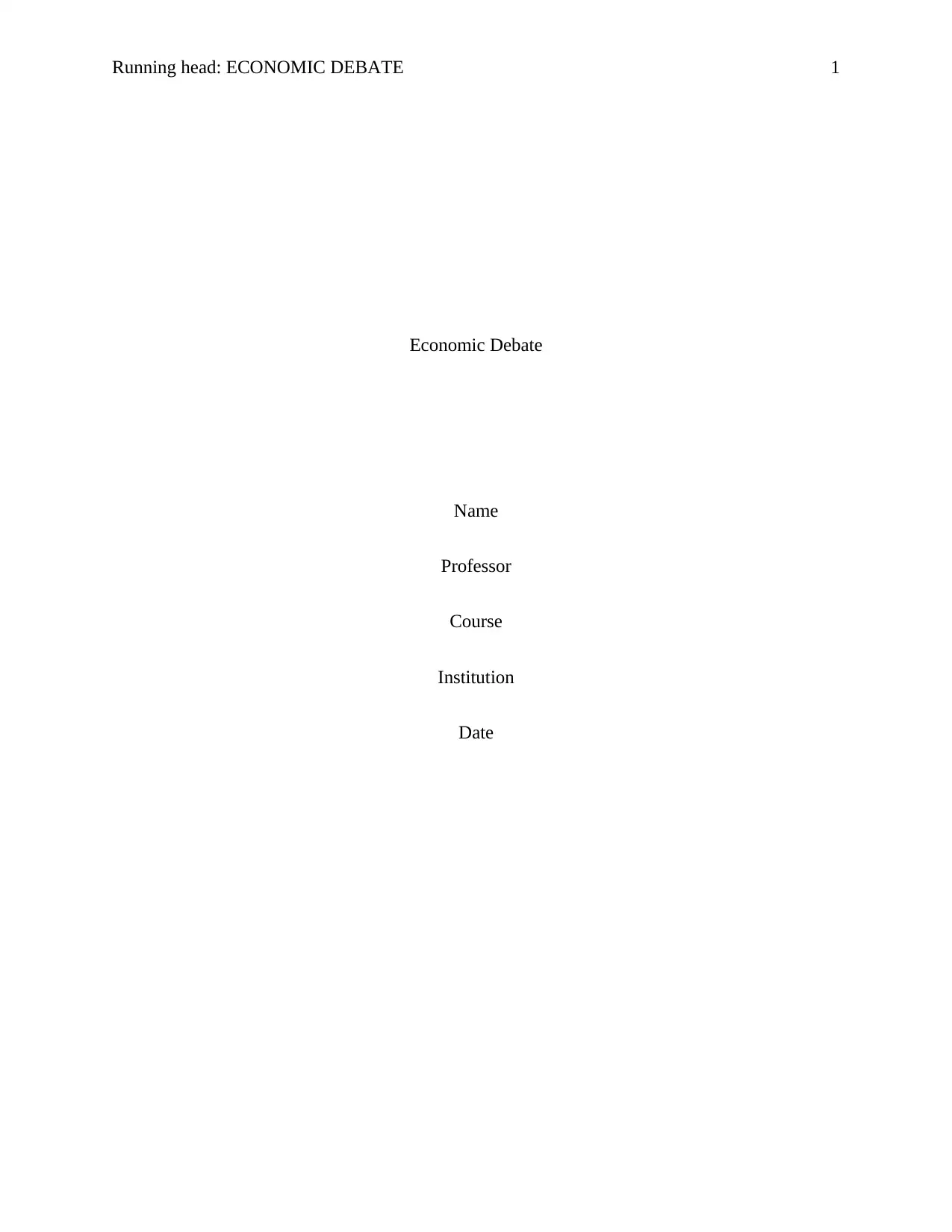
Running head: ECONOMIC DEBATE 1
Economic Debate
Name
Professor
Course
Institution
Date
Economic Debate
Name
Professor
Course
Institution
Date
Paraphrase This Document
Need a fresh take? Get an instant paraphrase of this document with our AI Paraphraser
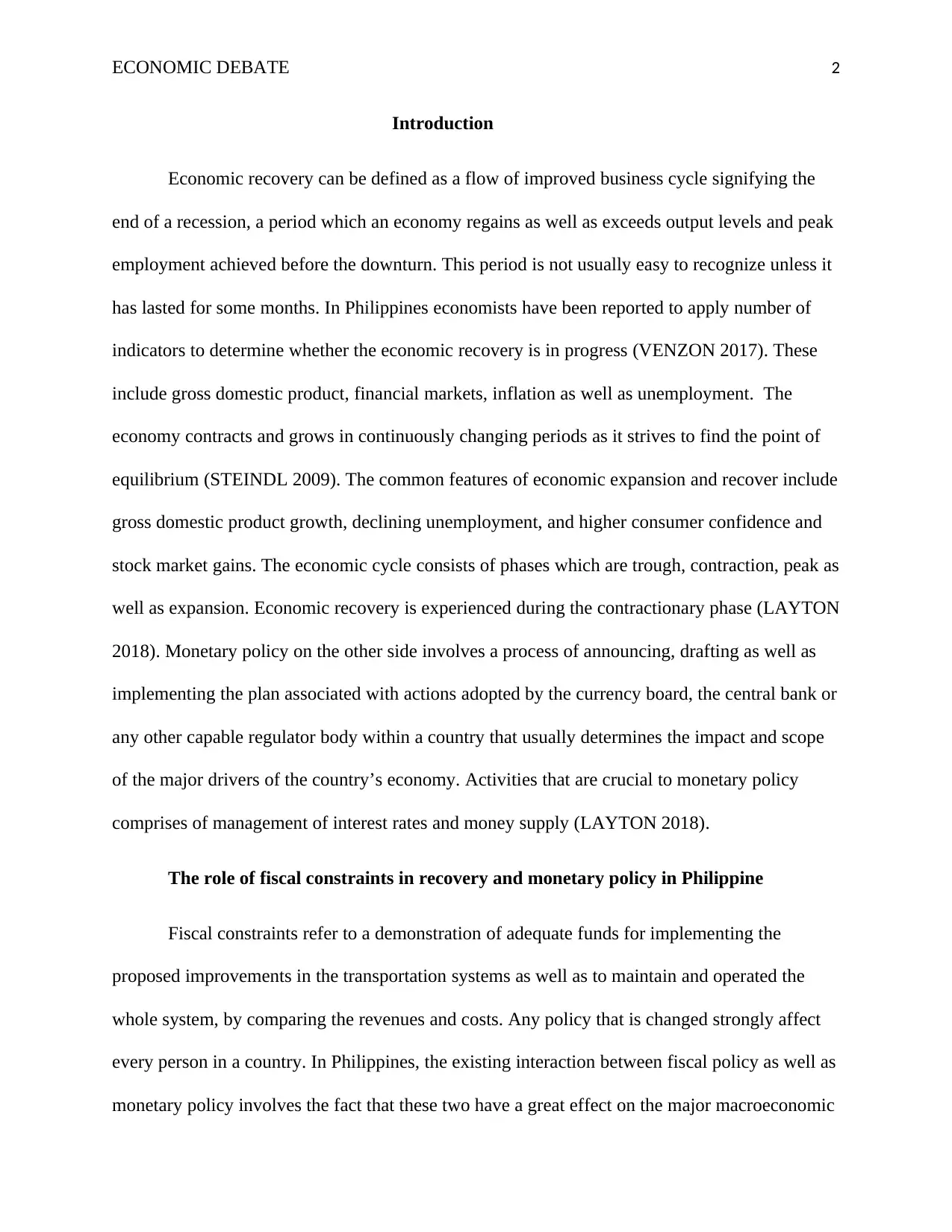
ECONOMIC DEBATE 2
Introduction
Economic recovery can be defined as a flow of improved business cycle signifying the
end of a recession, a period which an economy regains as well as exceeds output levels and peak
employment achieved before the downturn. This period is not usually easy to recognize unless it
has lasted for some months. In Philippines economists have been reported to apply number of
indicators to determine whether the economic recovery is in progress (VENZON 2017). These
include gross domestic product, financial markets, inflation as well as unemployment. The
economy contracts and grows in continuously changing periods as it strives to find the point of
equilibrium (STEINDL 2009). The common features of economic expansion and recover include
gross domestic product growth, declining unemployment, and higher consumer confidence and
stock market gains. The economic cycle consists of phases which are trough, contraction, peak as
well as expansion. Economic recovery is experienced during the contractionary phase (LAYTON
2018). Monetary policy on the other side involves a process of announcing, drafting as well as
implementing the plan associated with actions adopted by the currency board, the central bank or
any other capable regulator body within a country that usually determines the impact and scope
of the major drivers of the country’s economy. Activities that are crucial to monetary policy
comprises of management of interest rates and money supply (LAYTON 2018).
The role of fiscal constraints in recovery and monetary policy in Philippine
Fiscal constraints refer to a demonstration of adequate funds for implementing the
proposed improvements in the transportation systems as well as to maintain and operated the
whole system, by comparing the revenues and costs. Any policy that is changed strongly affect
every person in a country. In Philippines, the existing interaction between fiscal policy as well as
monetary policy involves the fact that these two have a great effect on the major macroeconomic
Introduction
Economic recovery can be defined as a flow of improved business cycle signifying the
end of a recession, a period which an economy regains as well as exceeds output levels and peak
employment achieved before the downturn. This period is not usually easy to recognize unless it
has lasted for some months. In Philippines economists have been reported to apply number of
indicators to determine whether the economic recovery is in progress (VENZON 2017). These
include gross domestic product, financial markets, inflation as well as unemployment. The
economy contracts and grows in continuously changing periods as it strives to find the point of
equilibrium (STEINDL 2009). The common features of economic expansion and recover include
gross domestic product growth, declining unemployment, and higher consumer confidence and
stock market gains. The economic cycle consists of phases which are trough, contraction, peak as
well as expansion. Economic recovery is experienced during the contractionary phase (LAYTON
2018). Monetary policy on the other side involves a process of announcing, drafting as well as
implementing the plan associated with actions adopted by the currency board, the central bank or
any other capable regulator body within a country that usually determines the impact and scope
of the major drivers of the country’s economy. Activities that are crucial to monetary policy
comprises of management of interest rates and money supply (LAYTON 2018).
The role of fiscal constraints in recovery and monetary policy in Philippine
Fiscal constraints refer to a demonstration of adequate funds for implementing the
proposed improvements in the transportation systems as well as to maintain and operated the
whole system, by comparing the revenues and costs. Any policy that is changed strongly affect
every person in a country. In Philippines, the existing interaction between fiscal policy as well as
monetary policy involves the fact that these two have a great effect on the major macroeconomic
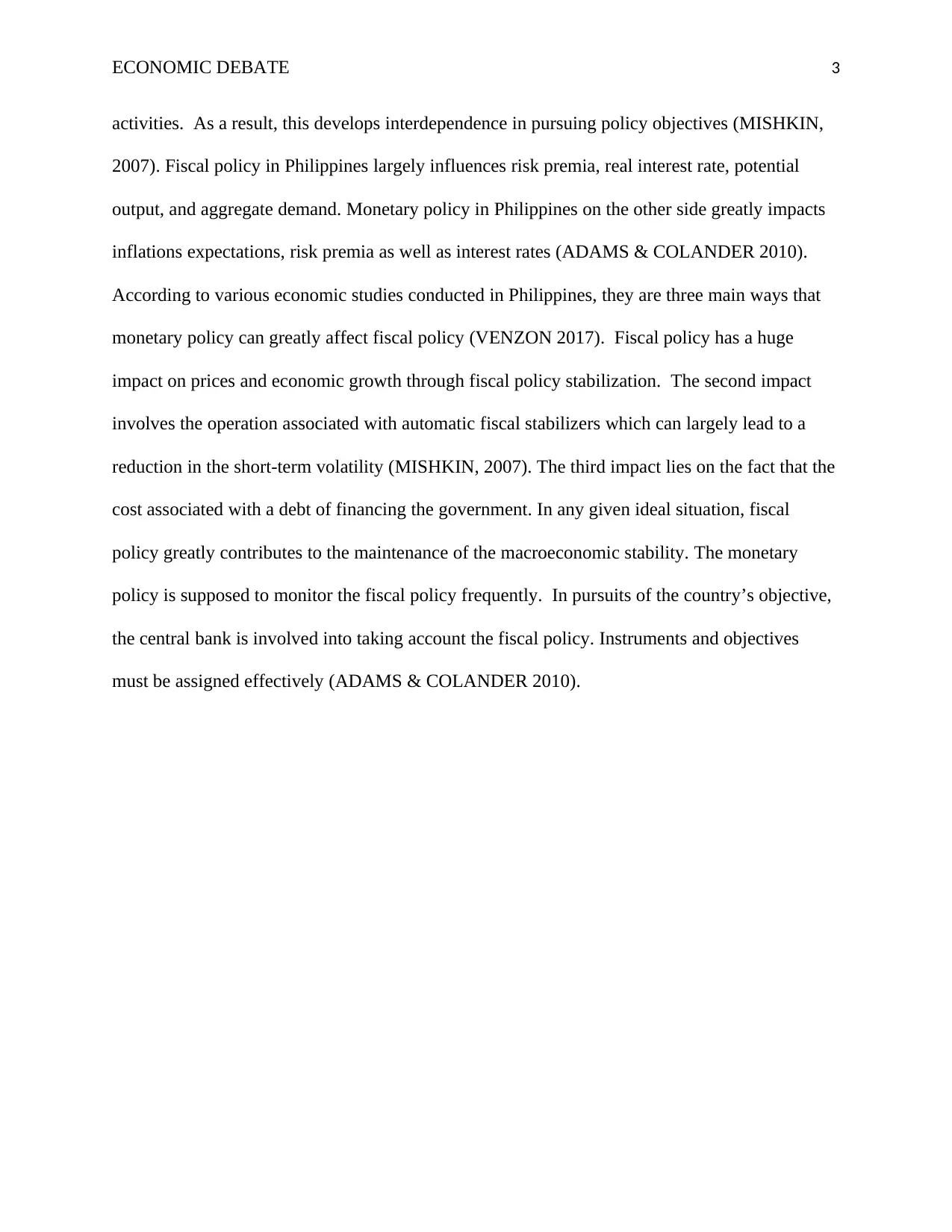
ECONOMIC DEBATE 3
activities. As a result, this develops interdependence in pursuing policy objectives (MISHKIN,
2007). Fiscal policy in Philippines largely influences risk premia, real interest rate, potential
output, and aggregate demand. Monetary policy in Philippines on the other side greatly impacts
inflations expectations, risk premia as well as interest rates (ADAMS & COLANDER 2010).
According to various economic studies conducted in Philippines, they are three main ways that
monetary policy can greatly affect fiscal policy (VENZON 2017). Fiscal policy has a huge
impact on prices and economic growth through fiscal policy stabilization. The second impact
involves the operation associated with automatic fiscal stabilizers which can largely lead to a
reduction in the short-term volatility (MISHKIN, 2007). The third impact lies on the fact that the
cost associated with a debt of financing the government. In any given ideal situation, fiscal
policy greatly contributes to the maintenance of the macroeconomic stability. The monetary
policy is supposed to monitor the fiscal policy frequently. In pursuits of the country’s objective,
the central bank is involved into taking account the fiscal policy. Instruments and objectives
must be assigned effectively (ADAMS & COLANDER 2010).
activities. As a result, this develops interdependence in pursuing policy objectives (MISHKIN,
2007). Fiscal policy in Philippines largely influences risk premia, real interest rate, potential
output, and aggregate demand. Monetary policy in Philippines on the other side greatly impacts
inflations expectations, risk premia as well as interest rates (ADAMS & COLANDER 2010).
According to various economic studies conducted in Philippines, they are three main ways that
monetary policy can greatly affect fiscal policy (VENZON 2017). Fiscal policy has a huge
impact on prices and economic growth through fiscal policy stabilization. The second impact
involves the operation associated with automatic fiscal stabilizers which can largely lead to a
reduction in the short-term volatility (MISHKIN, 2007). The third impact lies on the fact that the
cost associated with a debt of financing the government. In any given ideal situation, fiscal
policy greatly contributes to the maintenance of the macroeconomic stability. The monetary
policy is supposed to monitor the fiscal policy frequently. In pursuits of the country’s objective,
the central bank is involved into taking account the fiscal policy. Instruments and objectives
must be assigned effectively (ADAMS & COLANDER 2010).
⊘ This is a preview!⊘
Do you want full access?
Subscribe today to unlock all pages.

Trusted by 1+ million students worldwide
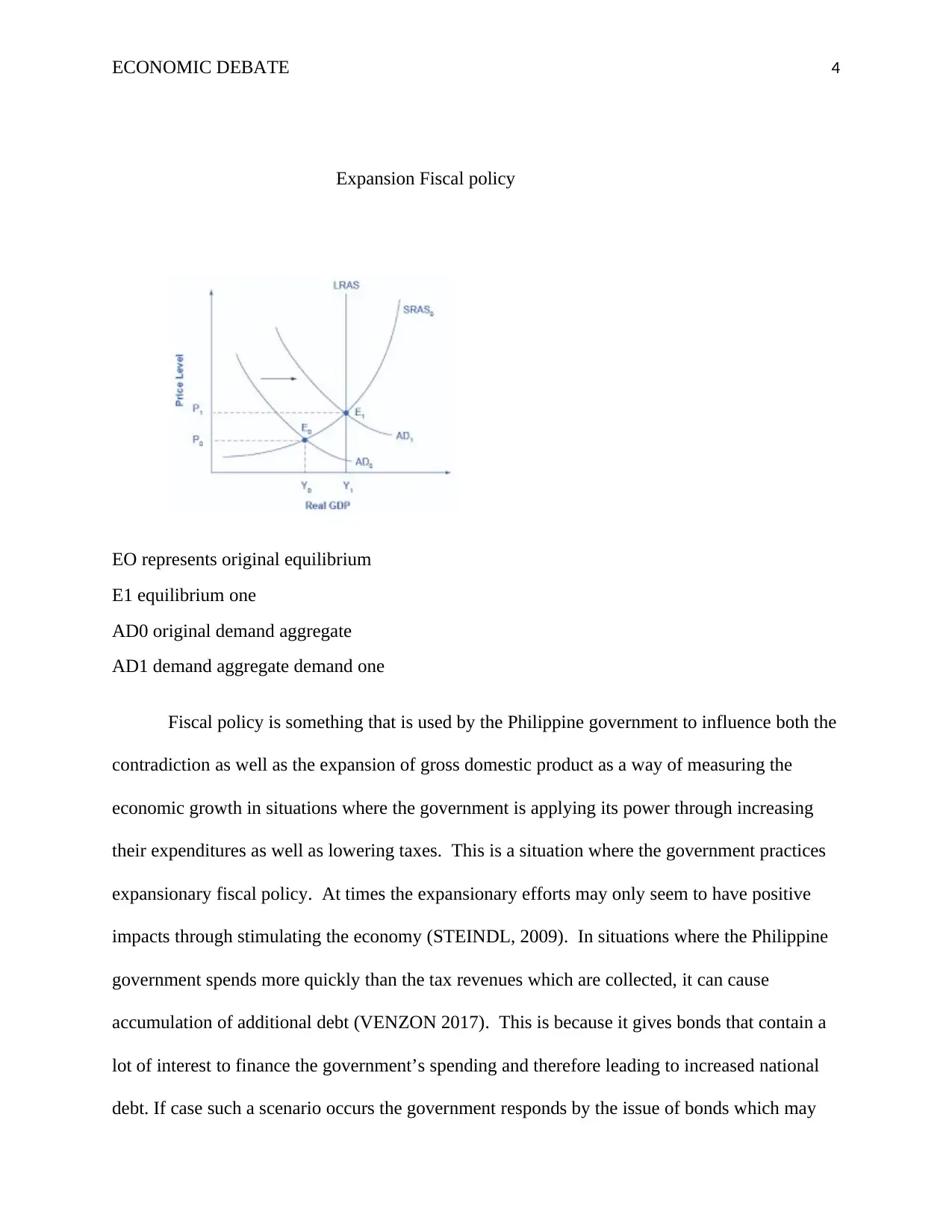
ECONOMIC DEBATE 4
Expansion Fiscal policy
EO represents original equilibrium
E1 equilibrium one
AD0 original demand aggregate
AD1 demand aggregate demand one
Fiscal policy is something that is used by the Philippine government to influence both the
contradiction as well as the expansion of gross domestic product as a way of measuring the
economic growth in situations where the government is applying its power through increasing
their expenditures as well as lowering taxes. This is a situation where the government practices
expansionary fiscal policy. At times the expansionary efforts may only seem to have positive
impacts through stimulating the economy (STEINDL, 2009). In situations where the Philippine
government spends more quickly than the tax revenues which are collected, it can cause
accumulation of additional debt (VENZON 2017). This is because it gives bonds that contain a
lot of interest to finance the government’s spending and therefore leading to increased national
debt. If case such a scenario occurs the government responds by the issue of bonds which may
Expansion Fiscal policy
EO represents original equilibrium
E1 equilibrium one
AD0 original demand aggregate
AD1 demand aggregate demand one
Fiscal policy is something that is used by the Philippine government to influence both the
contradiction as well as the expansion of gross domestic product as a way of measuring the
economic growth in situations where the government is applying its power through increasing
their expenditures as well as lowering taxes. This is a situation where the government practices
expansionary fiscal policy. At times the expansionary efforts may only seem to have positive
impacts through stimulating the economy (STEINDL, 2009). In situations where the Philippine
government spends more quickly than the tax revenues which are collected, it can cause
accumulation of additional debt (VENZON 2017). This is because it gives bonds that contain a
lot of interest to finance the government’s spending and therefore leading to increased national
debt. If case such a scenario occurs the government responds by the issue of bonds which may
Paraphrase This Document
Need a fresh take? Get an instant paraphrase of this document with our AI Paraphraser
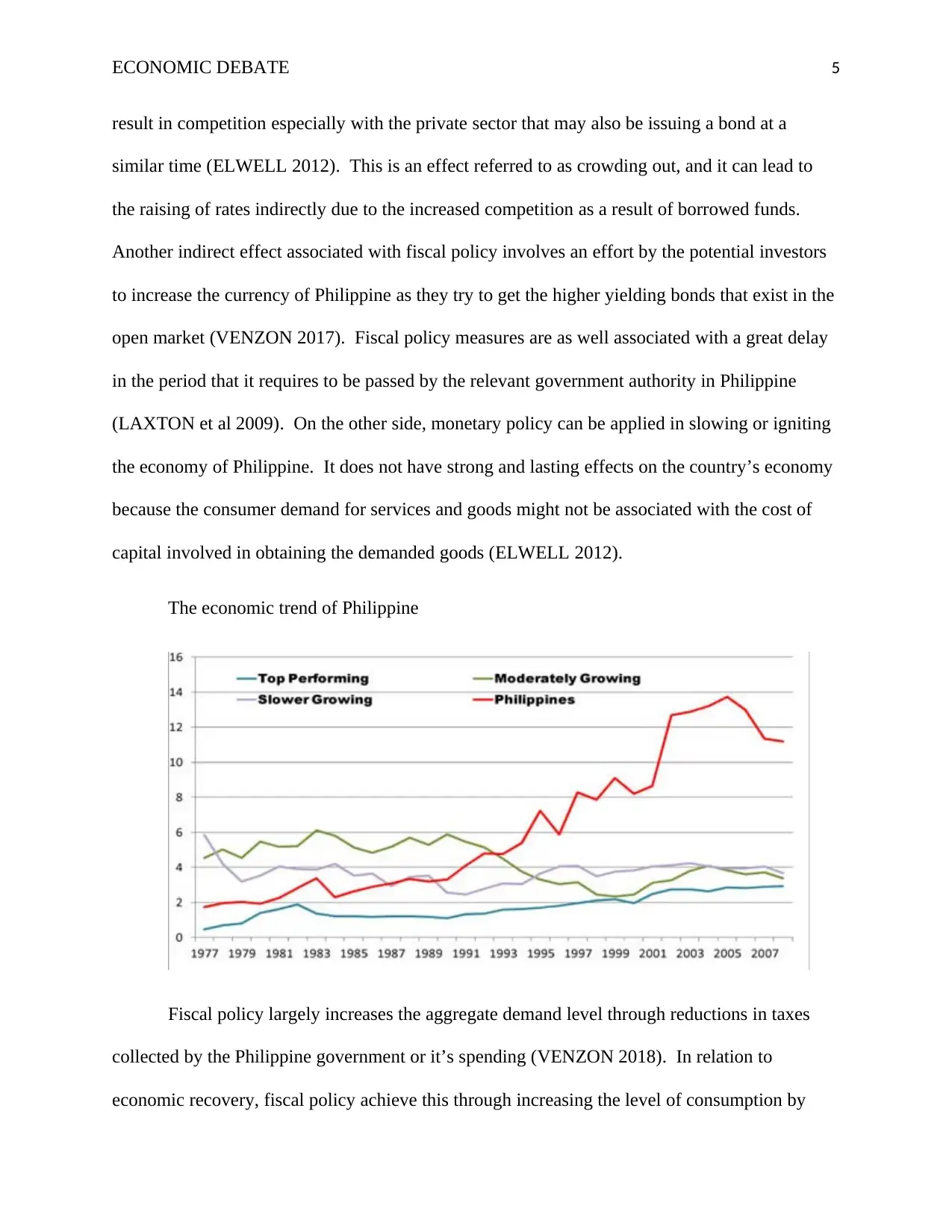
ECONOMIC DEBATE 5
result in competition especially with the private sector that may also be issuing a bond at a
similar time (ELWELL 2012). This is an effect referred to as crowding out, and it can lead to
the raising of rates indirectly due to the increased competition as a result of borrowed funds.
Another indirect effect associated with fiscal policy involves an effort by the potential investors
to increase the currency of Philippine as they try to get the higher yielding bonds that exist in the
open market (VENZON 2017). Fiscal policy measures are as well associated with a great delay
in the period that it requires to be passed by the relevant government authority in Philippine
(LAXTON et al 2009). On the other side, monetary policy can be applied in slowing or igniting
the economy of Philippine. It does not have strong and lasting effects on the country’s economy
because the consumer demand for services and goods might not be associated with the cost of
capital involved in obtaining the demanded goods (ELWELL 2012).
The economic trend of Philippine
Fiscal policy largely increases the aggregate demand level through reductions in taxes
collected by the Philippine government or it’s spending (VENZON 2018). In relation to
economic recovery, fiscal policy achieve this through increasing the level of consumption by
result in competition especially with the private sector that may also be issuing a bond at a
similar time (ELWELL 2012). This is an effect referred to as crowding out, and it can lead to
the raising of rates indirectly due to the increased competition as a result of borrowed funds.
Another indirect effect associated with fiscal policy involves an effort by the potential investors
to increase the currency of Philippine as they try to get the higher yielding bonds that exist in the
open market (VENZON 2017). Fiscal policy measures are as well associated with a great delay
in the period that it requires to be passed by the relevant government authority in Philippine
(LAXTON et al 2009). On the other side, monetary policy can be applied in slowing or igniting
the economy of Philippine. It does not have strong and lasting effects on the country’s economy
because the consumer demand for services and goods might not be associated with the cost of
capital involved in obtaining the demanded goods (ELWELL 2012).
The economic trend of Philippine
Fiscal policy largely increases the aggregate demand level through reductions in taxes
collected by the Philippine government or it’s spending (VENZON 2018). In relation to
economic recovery, fiscal policy achieve this through increasing the level of consumption by

ECONOMIC DEBATE 6
increasing the disposable income of the country (STEINDL, 2009). This can be achieved by cuts
in personal payroll taxes or income taxes. This also achieved through raising the investments
level in Philippine. This can be achieved through increasing after-tax profits by cutting taxes in
the business. Recession, inflation as well unemployment can also be reduced in the economy of
Philippine through raising the purchases of governments through increasing the spending of the
government on final services and goods (OHANIAN, TAYLOR & WRIGHT, 2012). This is
achieved through raising the federal grants to the governments with the aim of increasing their
expenditures on final services and goods. However the use of contractionary fiscal policy does
the opposite of this, it decreases the aggregate demand level by decreasing investments,
government spending as well as decreasing investments. This is done through cutting increasing
taxes as well as government spending (BOEHLING 2010).
The role of demand stimulus in recovery and monetary policy in Philippine
Demand stimulus comprises efforts by both the government of Philippine as well as its
agencies to stimulate an economy financially. A demand stimulus is the use of fiscal or monetary
policy variations to start growth during a recession. The government can come up with strategies
such as increasing its spending, lowering the rates of interest and quantitative easing to
accomplish this growth (MISHKIN, 2007). The Philippine governments may want to change the
composition and pace of economic growth within the country using the tools that are readily
available to them (VENZON 2018). The Philippine government may choose to use monetary and
fiscal policy tools for stimulating economic growth. Correspondingly, the government may also
wish to engage in stimulus outflow by coming up with projects or enacting policies that endorse
investments in the private sector (MORGAN 2012).
increasing the disposable income of the country (STEINDL, 2009). This can be achieved by cuts
in personal payroll taxes or income taxes. This also achieved through raising the investments
level in Philippine. This can be achieved through increasing after-tax profits by cutting taxes in
the business. Recession, inflation as well unemployment can also be reduced in the economy of
Philippine through raising the purchases of governments through increasing the spending of the
government on final services and goods (OHANIAN, TAYLOR & WRIGHT, 2012). This is
achieved through raising the federal grants to the governments with the aim of increasing their
expenditures on final services and goods. However the use of contractionary fiscal policy does
the opposite of this, it decreases the aggregate demand level by decreasing investments,
government spending as well as decreasing investments. This is done through cutting increasing
taxes as well as government spending (BOEHLING 2010).
The role of demand stimulus in recovery and monetary policy in Philippine
Demand stimulus comprises efforts by both the government of Philippine as well as its
agencies to stimulate an economy financially. A demand stimulus is the use of fiscal or monetary
policy variations to start growth during a recession. The government can come up with strategies
such as increasing its spending, lowering the rates of interest and quantitative easing to
accomplish this growth (MISHKIN, 2007). The Philippine governments may want to change the
composition and pace of economic growth within the country using the tools that are readily
available to them (VENZON 2018). The Philippine government may choose to use monetary and
fiscal policy tools for stimulating economic growth. Correspondingly, the government may also
wish to engage in stimulus outflow by coming up with projects or enacting policies that endorse
investments in the private sector (MORGAN 2012).
⊘ This is a preview!⊘
Do you want full access?
Subscribe today to unlock all pages.

Trusted by 1+ million students worldwide
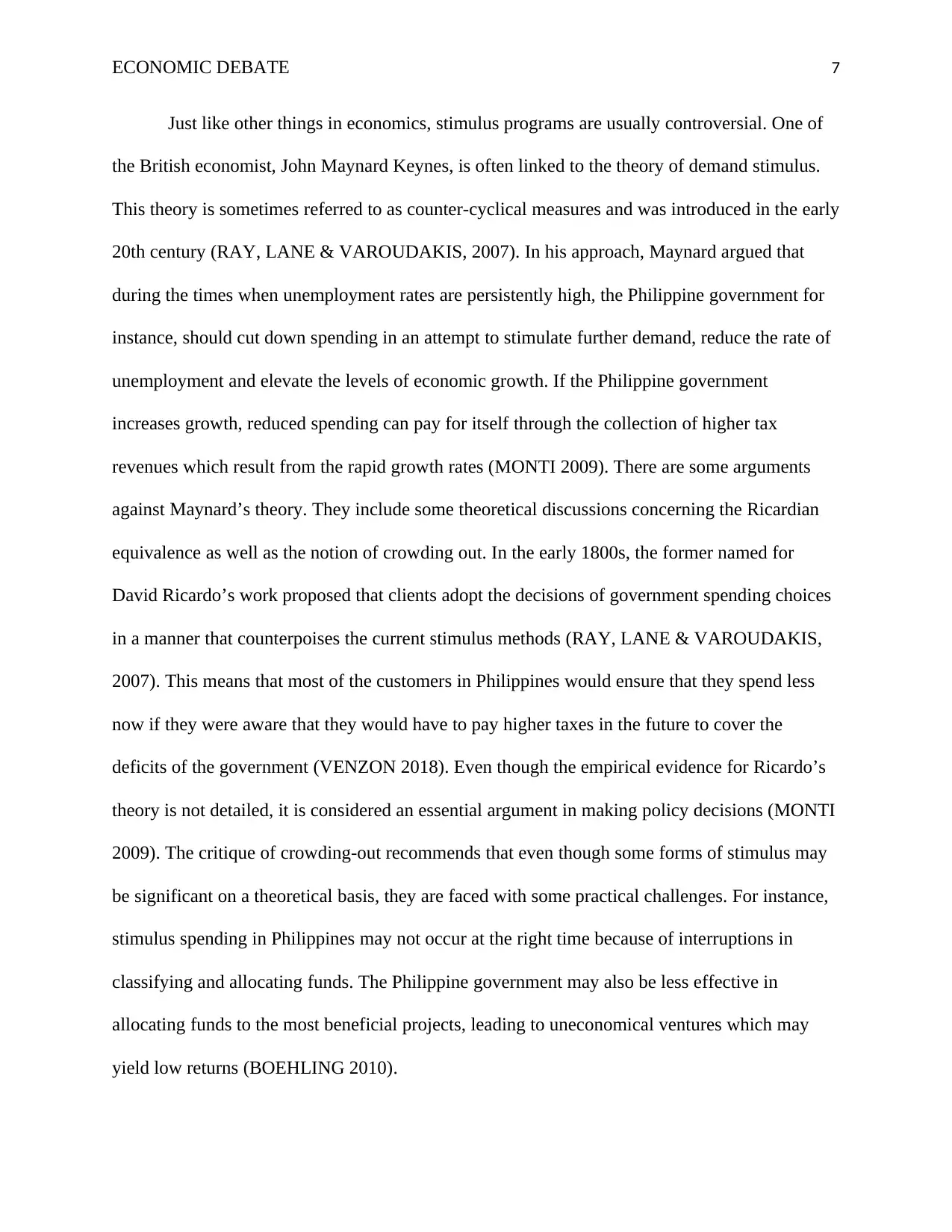
ECONOMIC DEBATE 7
Just like other things in economics, stimulus programs are usually controversial. One of
the British economist, John Maynard Keynes, is often linked to the theory of demand stimulus.
This theory is sometimes referred to as counter-cyclical measures and was introduced in the early
20th century (RAY, LANE & VAROUDAKIS, 2007). In his approach, Maynard argued that
during the times when unemployment rates are persistently high, the Philippine government for
instance, should cut down spending in an attempt to stimulate further demand, reduce the rate of
unemployment and elevate the levels of economic growth. If the Philippine government
increases growth, reduced spending can pay for itself through the collection of higher tax
revenues which result from the rapid growth rates (MONTI 2009). There are some arguments
against Maynard’s theory. They include some theoretical discussions concerning the Ricardian
equivalence as well as the notion of crowding out. In the early 1800s, the former named for
David Ricardo’s work proposed that clients adopt the decisions of government spending choices
in a manner that counterpoises the current stimulus methods (RAY, LANE & VAROUDAKIS,
2007). This means that most of the customers in Philippines would ensure that they spend less
now if they were aware that they would have to pay higher taxes in the future to cover the
deficits of the government (VENZON 2018). Even though the empirical evidence for Ricardo’s
theory is not detailed, it is considered an essential argument in making policy decisions (MONTI
2009). The critique of crowding-out recommends that even though some forms of stimulus may
be significant on a theoretical basis, they are faced with some practical challenges. For instance,
stimulus spending in Philippines may not occur at the right time because of interruptions in
classifying and allocating funds. The Philippine government may also be less effective in
allocating funds to the most beneficial projects, leading to uneconomical ventures which may
yield low returns (BOEHLING 2010).
Just like other things in economics, stimulus programs are usually controversial. One of
the British economist, John Maynard Keynes, is often linked to the theory of demand stimulus.
This theory is sometimes referred to as counter-cyclical measures and was introduced in the early
20th century (RAY, LANE & VAROUDAKIS, 2007). In his approach, Maynard argued that
during the times when unemployment rates are persistently high, the Philippine government for
instance, should cut down spending in an attempt to stimulate further demand, reduce the rate of
unemployment and elevate the levels of economic growth. If the Philippine government
increases growth, reduced spending can pay for itself through the collection of higher tax
revenues which result from the rapid growth rates (MONTI 2009). There are some arguments
against Maynard’s theory. They include some theoretical discussions concerning the Ricardian
equivalence as well as the notion of crowding out. In the early 1800s, the former named for
David Ricardo’s work proposed that clients adopt the decisions of government spending choices
in a manner that counterpoises the current stimulus methods (RAY, LANE & VAROUDAKIS,
2007). This means that most of the customers in Philippines would ensure that they spend less
now if they were aware that they would have to pay higher taxes in the future to cover the
deficits of the government (VENZON 2018). Even though the empirical evidence for Ricardo’s
theory is not detailed, it is considered an essential argument in making policy decisions (MONTI
2009). The critique of crowding-out recommends that even though some forms of stimulus may
be significant on a theoretical basis, they are faced with some practical challenges. For instance,
stimulus spending in Philippines may not occur at the right time because of interruptions in
classifying and allocating funds. The Philippine government may also be less effective in
allocating funds to the most beneficial projects, leading to uneconomical ventures which may
yield low returns (BOEHLING 2010).
Paraphrase This Document
Need a fresh take? Get an instant paraphrase of this document with our AI Paraphraser
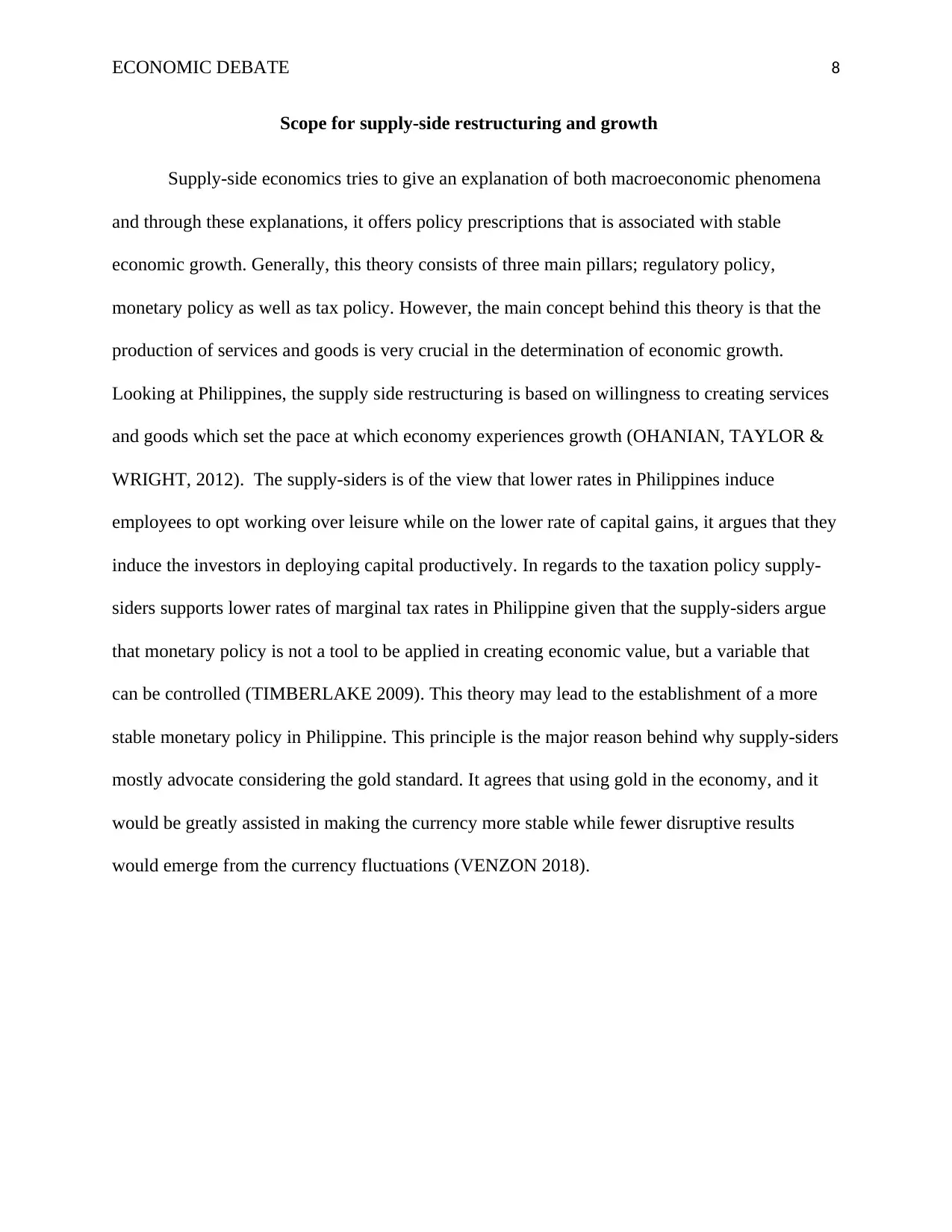
ECONOMIC DEBATE 8
Scope for supply-side restructuring and growth
Supply-side economics tries to give an explanation of both macroeconomic phenomena
and through these explanations, it offers policy prescriptions that is associated with stable
economic growth. Generally, this theory consists of three main pillars; regulatory policy,
monetary policy as well as tax policy. However, the main concept behind this theory is that the
production of services and goods is very crucial in the determination of economic growth.
Looking at Philippines, the supply side restructuring is based on willingness to creating services
and goods which set the pace at which economy experiences growth (OHANIAN, TAYLOR &
WRIGHT, 2012). The supply-siders is of the view that lower rates in Philippines induce
employees to opt working over leisure while on the lower rate of capital gains, it argues that they
induce the investors in deploying capital productively. In regards to the taxation policy supply-
siders supports lower rates of marginal tax rates in Philippine given that the supply-siders argue
that monetary policy is not a tool to be applied in creating economic value, but a variable that
can be controlled (TIMBERLAKE 2009). This theory may lead to the establishment of a more
stable monetary policy in Philippine. This principle is the major reason behind why supply-siders
mostly advocate considering the gold standard. It agrees that using gold in the economy, and it
would be greatly assisted in making the currency more stable while fewer disruptive results
would emerge from the currency fluctuations (VENZON 2018).
Scope for supply-side restructuring and growth
Supply-side economics tries to give an explanation of both macroeconomic phenomena
and through these explanations, it offers policy prescriptions that is associated with stable
economic growth. Generally, this theory consists of three main pillars; regulatory policy,
monetary policy as well as tax policy. However, the main concept behind this theory is that the
production of services and goods is very crucial in the determination of economic growth.
Looking at Philippines, the supply side restructuring is based on willingness to creating services
and goods which set the pace at which economy experiences growth (OHANIAN, TAYLOR &
WRIGHT, 2012). The supply-siders is of the view that lower rates in Philippines induce
employees to opt working over leisure while on the lower rate of capital gains, it argues that they
induce the investors in deploying capital productively. In regards to the taxation policy supply-
siders supports lower rates of marginal tax rates in Philippine given that the supply-siders argue
that monetary policy is not a tool to be applied in creating economic value, but a variable that
can be controlled (TIMBERLAKE 2009). This theory may lead to the establishment of a more
stable monetary policy in Philippine. This principle is the major reason behind why supply-siders
mostly advocate considering the gold standard. It agrees that using gold in the economy, and it
would be greatly assisted in making the currency more stable while fewer disruptive results
would emerge from the currency fluctuations (VENZON 2018).
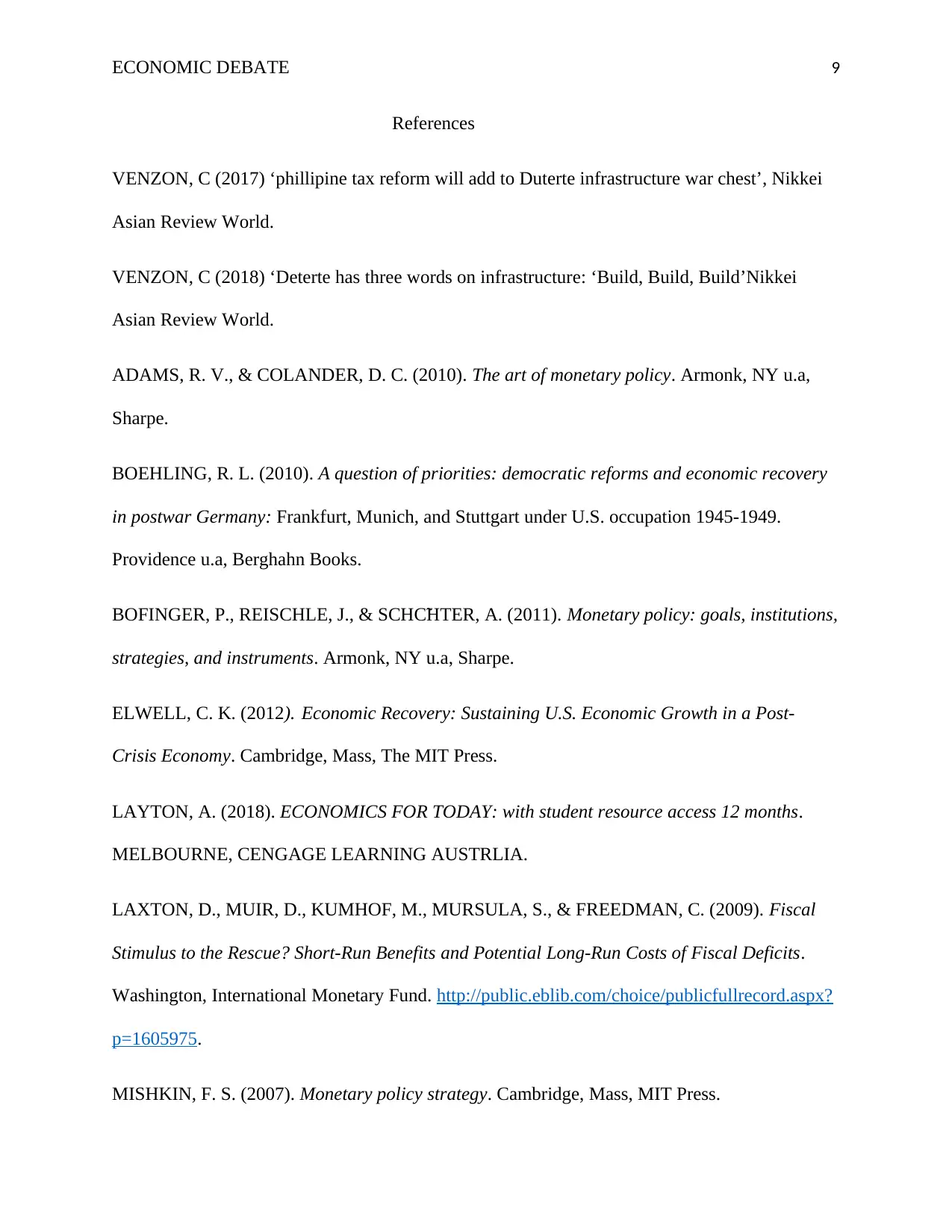
ECONOMIC DEBATE 9
References
VENZON, C (2017) ‘phillipine tax reform will add to Duterte infrastructure war chest’, Nikkei
Asian Review World.
VENZON, C (2018) ‘Deterte has three words on infrastructure: ‘Build, Build, Build’Nikkei
Asian Review World.
ADAMS, R. V., & COLANDER, D. C. (2010). The art of monetary policy. Armonk, NY u.a,
Sharpe.
BOEHLING, R. L. (2010). A question of priorities: democratic reforms and economic recovery
in postwar Germany: Frankfurt, Munich, and Stuttgart under U.S. occupation 1945-1949.
Providence u.a, Berghahn Books.
BOFINGER, P., REISCHLE, J., & SCHC̃HTER, A. (2011). Monetary policy: goals, institutions,
strategies, and instruments. Armonk, NY u.a, Sharpe.
ELWELL, C. K. (2012). Economic Recovery: Sustaining U.S. Economic Growth in a Post-
Crisis Economy. Cambridge, Mass, The MIT Press.
LAYTON, A. (2018). ECONOMICS FOR TODAY: with student resource access 12 months.
MELBOURNE, CENGAGE LEARNING AUSTRLIA.
LAXTON, D., MUIR, D., KUMHOF, M., MURSULA, S., & FREEDMAN, C. (2009). Fiscal
Stimulus to the Rescue? Short-Run Benefits and Potential Long-Run Costs of Fiscal Deficits.
Washington, International Monetary Fund. http://public.eblib.com/choice/publicfullrecord.aspx?
p=1605975.
MISHKIN, F. S. (2007). Monetary policy strategy. Cambridge, Mass, MIT Press.
References
VENZON, C (2017) ‘phillipine tax reform will add to Duterte infrastructure war chest’, Nikkei
Asian Review World.
VENZON, C (2018) ‘Deterte has three words on infrastructure: ‘Build, Build, Build’Nikkei
Asian Review World.
ADAMS, R. V., & COLANDER, D. C. (2010). The art of monetary policy. Armonk, NY u.a,
Sharpe.
BOEHLING, R. L. (2010). A question of priorities: democratic reforms and economic recovery
in postwar Germany: Frankfurt, Munich, and Stuttgart under U.S. occupation 1945-1949.
Providence u.a, Berghahn Books.
BOFINGER, P., REISCHLE, J., & SCHC̃HTER, A. (2011). Monetary policy: goals, institutions,
strategies, and instruments. Armonk, NY u.a, Sharpe.
ELWELL, C. K. (2012). Economic Recovery: Sustaining U.S. Economic Growth in a Post-
Crisis Economy. Cambridge, Mass, The MIT Press.
LAYTON, A. (2018). ECONOMICS FOR TODAY: with student resource access 12 months.
MELBOURNE, CENGAGE LEARNING AUSTRLIA.
LAXTON, D., MUIR, D., KUMHOF, M., MURSULA, S., & FREEDMAN, C. (2009). Fiscal
Stimulus to the Rescue? Short-Run Benefits and Potential Long-Run Costs of Fiscal Deficits.
Washington, International Monetary Fund. http://public.eblib.com/choice/publicfullrecord.aspx?
p=1605975.
MISHKIN, F. S. (2007). Monetary policy strategy. Cambridge, Mass, MIT Press.
⊘ This is a preview!⊘
Do you want full access?
Subscribe today to unlock all pages.

Trusted by 1+ million students worldwide
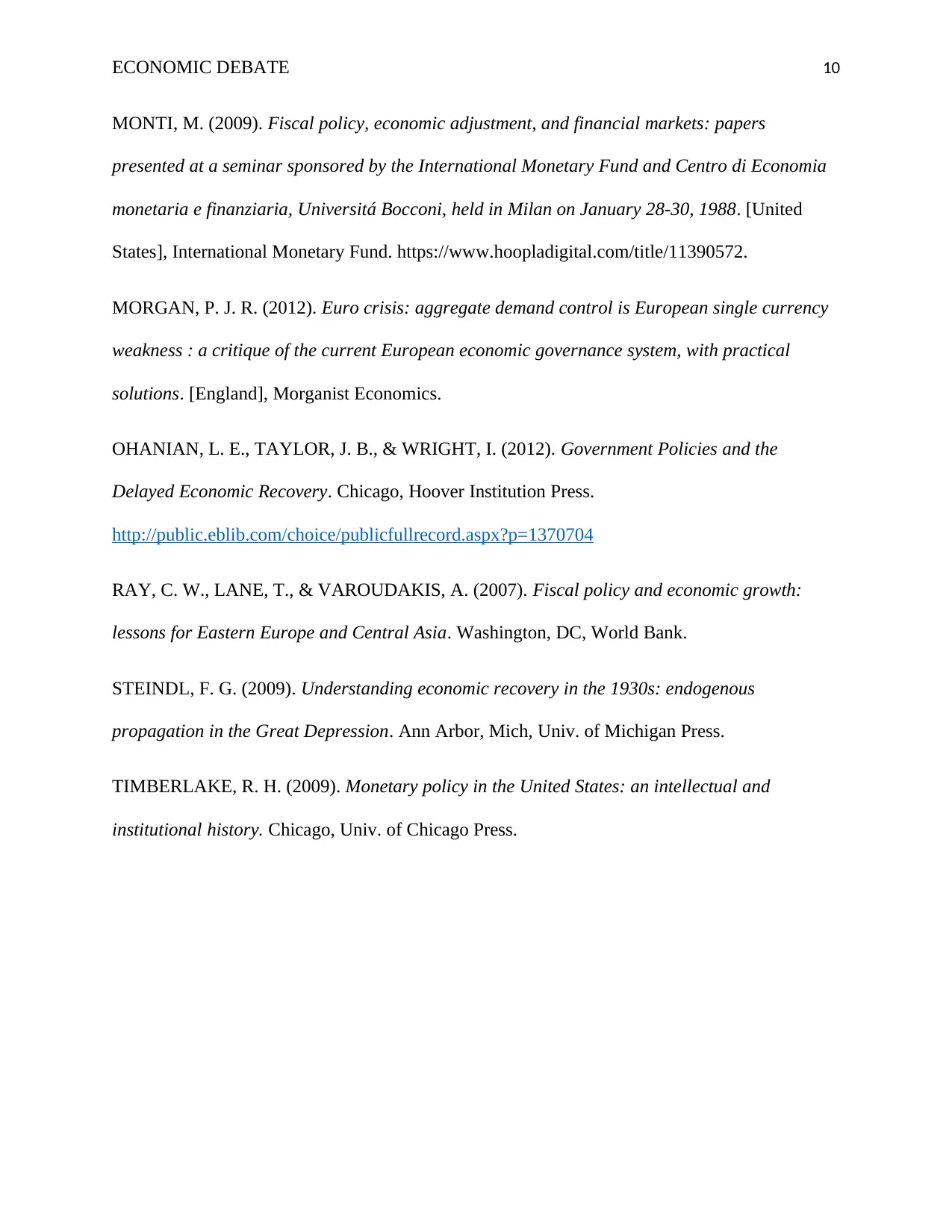
ECONOMIC DEBATE 10
MONTI, M. (2009). Fiscal policy, economic adjustment, and financial markets: papers
presented at a seminar sponsored by the International Monetary Fund and Centro di Economia
monetaria e finanziaria, Universitá Bocconi, held in Milan on January 28-30, 1988 . [United
States], International Monetary Fund. https://www.hoopladigital.com/title/11390572.
MORGAN, P. J. R. (2012). Euro crisis: aggregate demand control is European single currency
weakness : a critique of the current European economic governance system, with practical
solutions. [England], Morganist Economics.
OHANIAN, L. E., TAYLOR, J. B., & WRIGHT, I. (2012). Government Policies and the
Delayed Economic Recovery. Chicago, Hoover Institution Press.
http://public.eblib.com/choice/publicfullrecord.aspx?p=1370704
RAY, C. W., LANE, T., & VAROUDAKIS, A. (2007). Fiscal policy and economic growth:
lessons for Eastern Europe and Central Asia. Washington, DC, World Bank.
STEINDL, F. G. (2009). Understanding economic recovery in the 1930s: endogenous
propagation in the Great Depression. Ann Arbor, Mich, Univ. of Michigan Press.
TIMBERLAKE, R. H. (2009). Monetary policy in the United States: an intellectual and
institutional history. Chicago, Univ. of Chicago Press.
MONTI, M. (2009). Fiscal policy, economic adjustment, and financial markets: papers
presented at a seminar sponsored by the International Monetary Fund and Centro di Economia
monetaria e finanziaria, Universitá Bocconi, held in Milan on January 28-30, 1988 . [United
States], International Monetary Fund. https://www.hoopladigital.com/title/11390572.
MORGAN, P. J. R. (2012). Euro crisis: aggregate demand control is European single currency
weakness : a critique of the current European economic governance system, with practical
solutions. [England], Morganist Economics.
OHANIAN, L. E., TAYLOR, J. B., & WRIGHT, I. (2012). Government Policies and the
Delayed Economic Recovery. Chicago, Hoover Institution Press.
http://public.eblib.com/choice/publicfullrecord.aspx?p=1370704
RAY, C. W., LANE, T., & VAROUDAKIS, A. (2007). Fiscal policy and economic growth:
lessons for Eastern Europe and Central Asia. Washington, DC, World Bank.
STEINDL, F. G. (2009). Understanding economic recovery in the 1930s: endogenous
propagation in the Great Depression. Ann Arbor, Mich, Univ. of Michigan Press.
TIMBERLAKE, R. H. (2009). Monetary policy in the United States: an intellectual and
institutional history. Chicago, Univ. of Chicago Press.
1 out of 10
Related Documents
Your All-in-One AI-Powered Toolkit for Academic Success.
+13062052269
info@desklib.com
Available 24*7 on WhatsApp / Email
![[object Object]](/_next/static/media/star-bottom.7253800d.svg)
Unlock your academic potential
Copyright © 2020–2025 A2Z Services. All Rights Reserved. Developed and managed by ZUCOL.





